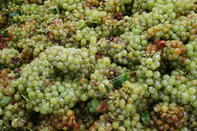Need to Know
When you find yourself in a crowded wine tasting room, surrounded by wine geeks who would all like your input on the ‘delicate’ dryness of the particular wine in question, fear not!

You don’t have to improvise on the spot and share how the taste reminds you of, uh, dry pencil shavings - learning the language of vino is easier than you think.
But first things first - you have to know the difference between sweet, semi-sweet, dry and semi-dry wine.
Sticky and Sweet

Sweet wines are usually more heavy and ‘creamy’, with a rich taste and, obviously, quite sweet. This is because grapes with high sugar content are used in the winemaking process, meaning that fermentation gets stopped before the yeast turns all the natural grape sugar into alcohol.
Our sense of smell greatly affects our perception of sweetness. If a wine smells sweeter, it will inherently taste sweeter. Such wines are referred to as ‘aromatic’ because of its sweet aroma. Residual sugars can be added to a wine to make it sweeter and counterbalance the acidity (sourness).
There are various categories of sweet white and red wine, each with its own distinct taste and colour. The categories are: sparkling, light & sweet, rich & sweet, sweet red and fortified. A popular summer sparkling wine is Rosé, a refreshing burst of fruitiness that quenches any thirst. Muscadels, Ports and Hanepoot are definitely rich & sweet winter drinks, characterised as a thick, sticky liquid that warms the body - such wines are meant to be savoured in small quantities, often drank after a meal as a sweet delicacy. Remember to use words like ‘rich’, ‘full-bodied’ and ‘aromatic’ when in the company of wine fanatics drinking sweet wine.
Further up the spectrum, you’ll find the likeable semi-sweet wine. It usually has a more acidic taste and is best enjoyed with a savoury meal. They are quite popular in both red and white wine varietals, as they are not too heavy - you might want to watch your intake because it’s an easy-drinking vino. The mild sweetness of semi-sweet wines makes it a palatable drink, with hints of fruit, honey and flowers (yes, flowers, apparently).
Dry as the Desert

Dry wines are for the classy wine connoisseurs that like to have the inside of their mouth stick to their teeth. That aside, this variety of wine is very enjoyable because of its acidity and, you know, some people like it when they have no saliva.
The key components to creating the perfect ‘dry wine’ are, of course, acidity (sourness), tannin (bitterness) and aroma. When combined, winemakers can produce a vast range of tasty wines that take the moisture from your mouth but makes you feel good on the inside (seriously, it’s a great feeling).
When sampling dry wines, be aware of the difference between white and red wines. Dry white wines are crisp and refreshing, offering tastes of lemon, grapefruit and herbs, while dry red wines are heavy and full-bodied, with notes of spices and berries. An interesting note to take into consideration are the proteins in your saliva - it might make your taste buds not feel the drying effect of tannin as much as people with less proteins.
Semi-dry wines, many people would argue, are the oasis between the dry desert and the sweet ocean. It’s light, easy to drink and contains the right amount of acidity, bitterness and hints of sweetness to satisfy almost any palate. And no, it’s not pencil shavings you are tasting - it’s most likely notes of nuts, cinnamon, tea leaves or dark chocolate.